DATELINE – Dallas, Texas July and August 2023
This special trail camera project began as an offshoot of another effort I spent some time working on this past summer. Over the course of several weeks in July and August, I endeavored to investigate and photograph a notable situation involving urban Swainson’s Hawks in far North Dallas. The hawks had nested along a deep-etched White Austin Chalk creek bed running through the heart of a very busy urban neighborhood–an unusual occurrence for North Texas in my experience.

This particular urban creek bed runs for several miles through mostly residential neighborhoods, but business parks and retail centers also abut its course as the branch makes its way through the city. Houses and other buildings crowd the creek on either side along its entire run. The creek’s channel is cut deep in its bed of Austin White Chalk, facilitating a shallow stream of clear, cool water that runs 15 feet or so below street level. At some point in its urban history, a trench was cut along the rocky creek bed, and a sewer line was laid down. The cement backfill is slightly elevated above the rest of the creek bed, creating a mostly dry sidewalk-of-sorts for significant intervals along the creek’s course.
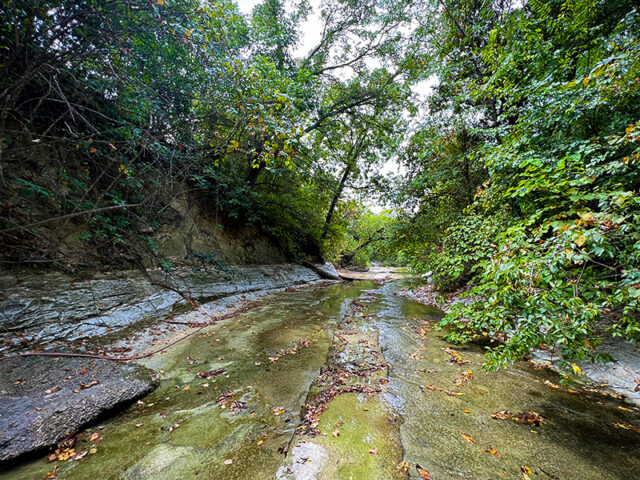
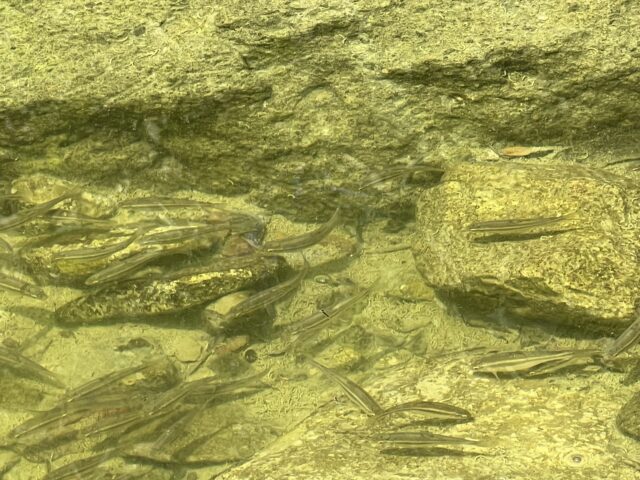
I accessed the assistance of an expert for this fish identification. He was able
to make a positive ID based partially on the shape and size of the
fish dropping visible in the photo
After spending multiple days around this unique urban habitat, I couldn’t help but to wonder what other kinds of wildlife it harbored. I decided to set some trail cameras in an effort to learn more. It was my hope that running a couple of cameras down in the creek bed for a few weeks would be very illuminating!
I was curious about how the local wildlife would make use of this unusual urban habitat. I had some pretty strong expectations, based on the many years I have spent observing urban wildlife–Raccoons, Raccoons, and more Raccoons fit the bill here, and I was sure I would get plenty of candid photographs of their antics.
I set a pair of trail cameras low in the creek bed, one pointing upstream and another aimed downstream. Pictures started coming in just after dark on the first night. As I reviewed those early photos, it didn’t take long for my expectations to be blown.
Raccoons were certainly a part of the mix–as expected. So too were Armadillos, Great Blue Herons, Black-crowned Night Herons, Bobcats, and Swainson’s Hawks. But the real surprise came when it turned out that the most frequently recorded animals were Coyotes. And there were ALOT of Coyotes making using this creek bed as their own personal secret passageway through the urban landscape.
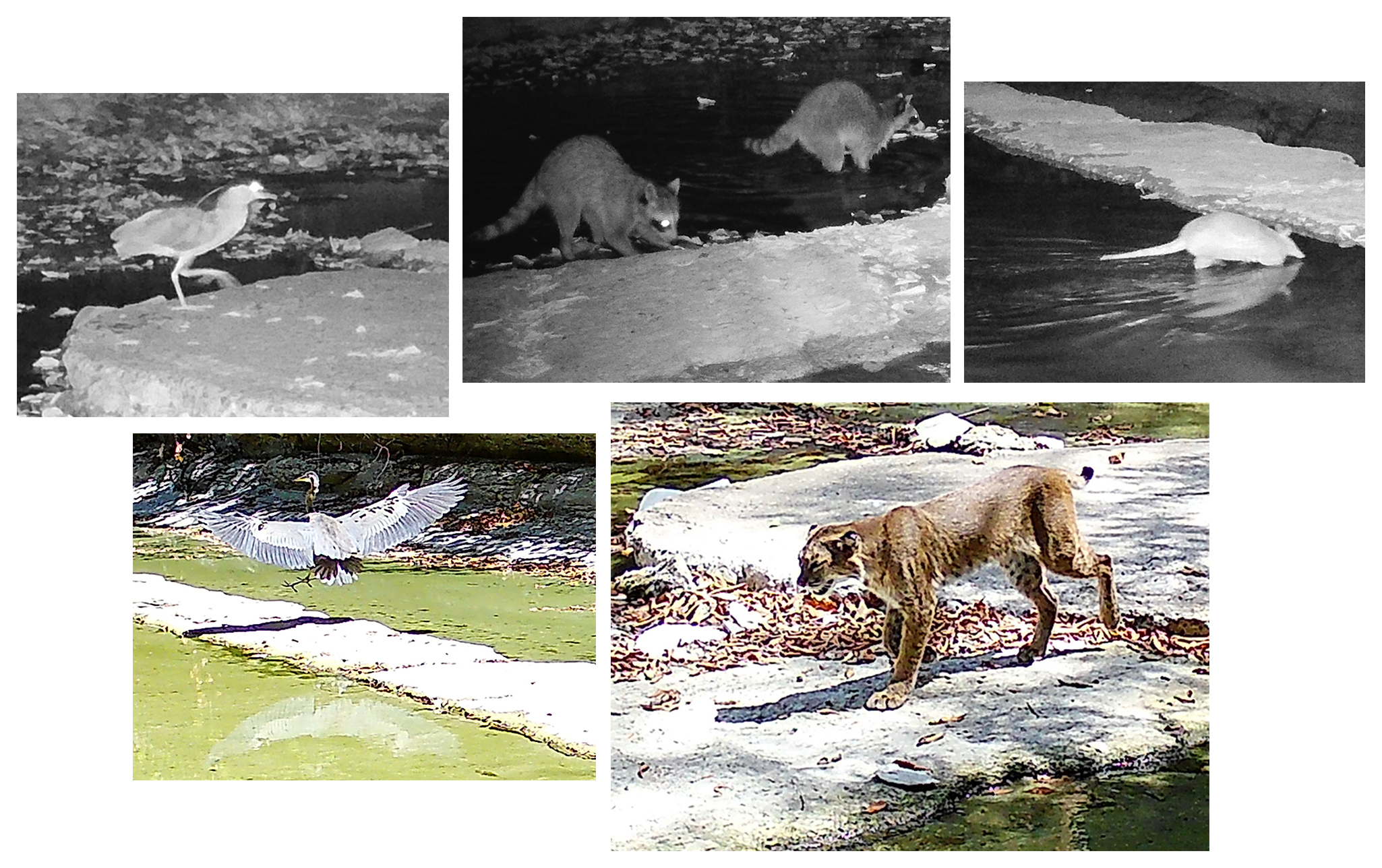
Raccoons, Armadillo, Great Blue Heron, and Bobcat.
Click Image to Enlarge
There were a couple of things about these urban Coyotes that quickly struct me as noteworthy. As I mentioned earlier, the sheer number of Coyotes moving through this space was amazing. Dozens of Coyote photographs were recorded each day. And although it is difficult to be absolutely certain, there appeared to be multiple family groups using this creek bed–possibly sharing the corridor despite overlapping territories. One of the family groups in particular was quite large, with at least seven individual Coyotes counted. See the video below…
Coyote pup mortality is usually very high… 50 percent or so. It is quite an accomplishment
to get five pups to this stage of their life. It’s an indication that the surrounding neighborhoods
are resource rich and good habitat for these Coyotes!
The other thing that was unique about this trail camera survey was the number of times I recorded pictures of Coyotes carrying captured prey animals. With so many family groups active in this area–each with multiple pups–I was not surprised to see that the Coyotes spent the bulk of their day securing prey. There were surely a lot of hungry mouths to feed!
I’ve recorded pictures of Coyotes with prey a number of times in the past, but never in such an urbanized part of town. In the Trinity River bottoms and other remote places around Dallas/Fort Worth it had always been wild game that the Coyotes had captured. Sometimes it was large birds, other times it was Cottontail Rabbits, but most frequently it was juvenile Raccoons.

a rabbit, a bird, the hind quarter of a fawn, and an Opossum.
Click Image to Enlarge
Juvenile Raccoons seem particularly vulnerable to Coyotes, possibly due to their tendency to sometimes find themselves on their own at a early age. When young Raccoons begin patrolling with their mothers, kits will occasionally get separated from the rest of the litter. The wayward juveniles either wander off or get left behind when the group moves on unexpectedly. An orphaned young Raccoon results.
Adult Raccoons have little to fear from Coyotes, and they can easily hold their own against even multiple attackers, but a juvenile Raccoon is at a decided disadvantage. Even at a relatively young age, many juvenile Raccoons are resourceful enough to find the food they need to survive–without their mother’s assistance–but they remain small enough to be vulnerable to predation.
During this survey, my trail cameras regularly recorded Raccoons working the creek after dark, so I was fairly certain they would be the main item on the Coyote’s menu here too–as they had been in so many other places around town. I even found the partially consumed carcass of a young Raccoon in the creek bed while I was setting up my cameras. So when the first few motioned-blurred images of Coyotes with prey began coming in, my expectation was that it would be juvenile Raccoons that they were carrying.

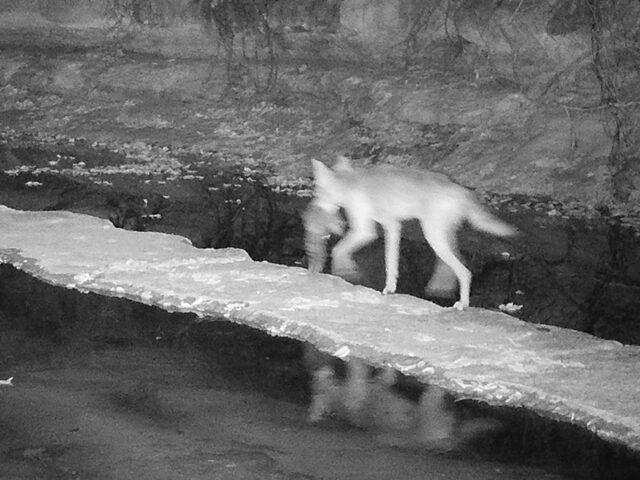
ascertain the type of prey animal this Coyote was carrying
But as clearer images began to recorded, it became quite clear that the Coyotes were not feeding on Raccoons. Instead–in almost every case–they were photographed carrying the remains of House Cats. Dozens and dozens of them. The shear number of cats being captured intrigued me. Where were the Coyotes finding that many House Cats!?!
It wasn’t long before I noticed that the Coyotes were always photographed carrying the cat carcasses away in the same direction. They always traveled upstream with their captures–never downstream. After a little investigation, I discovered the reason why.
Checking Google Maps I could see that just a short distance downstream there was a grouping of multiple apartment complexes straddling the creek. When I stopped by the apartments a few days later, I found an ample supply of feral cats at each complex. These apartments had become a veritable feral cat farm that the resourceful Coyotes were readily harvesting.
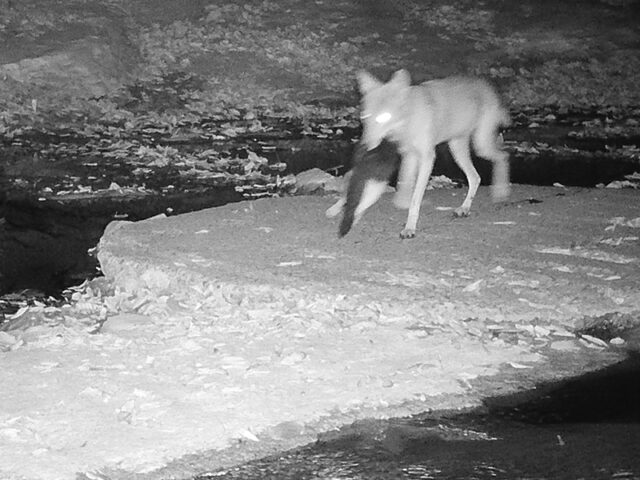
the Coyotes were regularly catching House Cats
Many of you reading this already have an understanding that Coyotes sometimes hunt and kill House Cats. For others, this may be new and upsetting information. Some people will be angry that the cats are being hunted and killed, and others will be frustrated that people are abandoning their pets in such large numbers and in such an irresponsible way.
Coyotes can be characterized as opportunistic predators. What this means is, that when the opportunity to hunt and kill a prey animal presents itself, a Coyote cannot typically afford to pass it up. Life for Coyotes is difficult and full of challenges–regardless of whether they live in the city or the country. Things like illness, injury, territorial disputes, or encounters with people or other animals can increase their hardships. Having pups to feed only makes things more difficult.
Coyotes typically hunt as individuals, even when multiple Coyotes patrol together. Though they work together to protect territories as family groups, Coyotes are not know to hunt cooperatively in packs the same way that their larger cousins the wolves do. Because of these factors, Coyotes prefer to hunt small game. Animals like rats and rabbits often make up the bulk of their diet. As noted earlier, juvenile Raccoons are also a staple. Coyotes will also partake of carrion when it is available. And under special circumstances they may work together to take down larger prey (such as a restrained or fenced domestic animal, or an injured deer or hog).
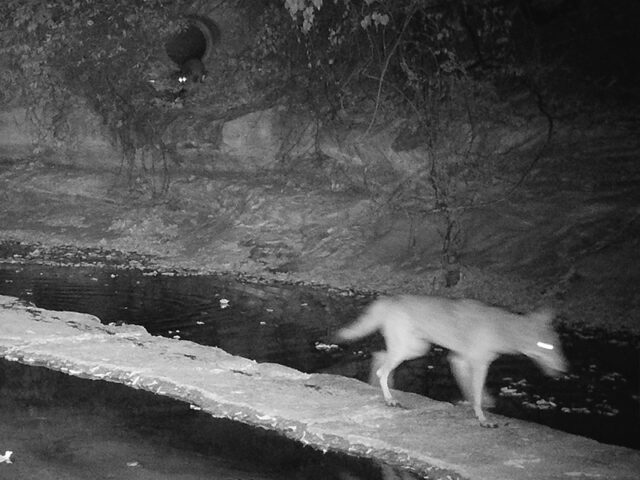
House Cats fit into the range of potential prey somewhere in the middle. House Cats are small enough to be manageable prey for Coyotes, while at the same time being large enough to provide a hearty meal. From the Coyote’s point of view, the effort to hunt cats is usually going to be low risk and high payoff.
For most well cared for House Cats the risk of being killed by an urban Coyote is extremely low, but it is still always in the mix of dangers that pet owners must be aware of. Just as it is the pet owner’s responsibility to protect their charges from threats like automobile traffic, disease, dogs, other cats, and even mean people, a cat owner must also consider the risk posed by urban Coyotes. The standard recommendation from most authorities is to always keep cats inside the house. It is good advice. Cats that are regularly allowed outdoors have an abbreviated life expectancy of only 2 to 5 years, while indoor cats may live as long as 12 to 18 years. That is quite a difference!
Finally, and perhaps the most straightforward way to prevent the outcome described in this article, is simply for people not to abandon their pet cats. It seems obvious enough. Potential pet owners should consider carefully whether they will be able to care for a cat for the full 12 to 18 years it is expected to live. And in the event it becomes impossible to keep a cat–for whatever reason–the cat should be turned it into a shelter or a rescue rather than being abandoned to make its own way. Without human intervention, Feral Cats lead short, hardship-filled lives. The answer to this issue is remarkably uncomplicated, yet it remains frustratingly out of reach, and House Cats continued to be abandoned in prodigious numbers. A fact that doesn’t appear likely to change any time soon.

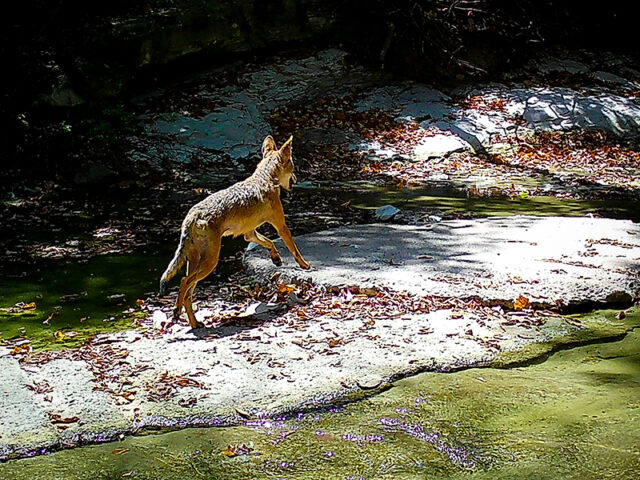
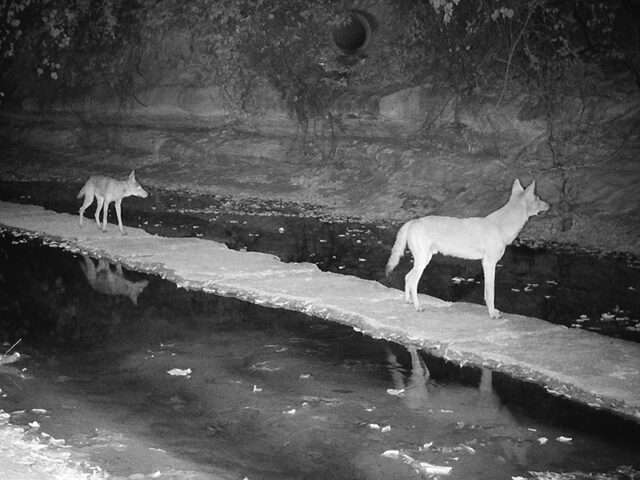

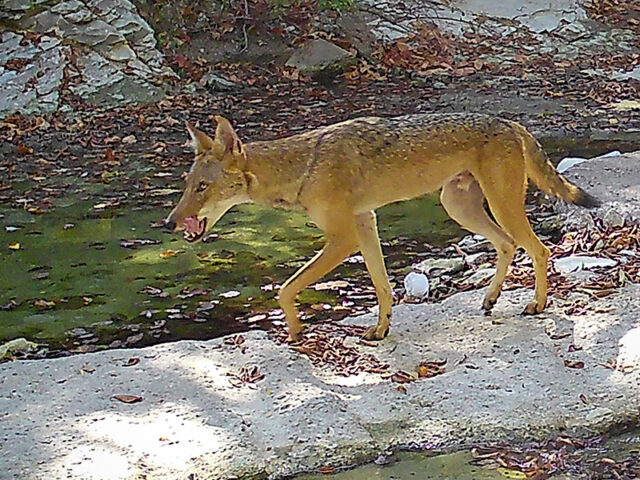
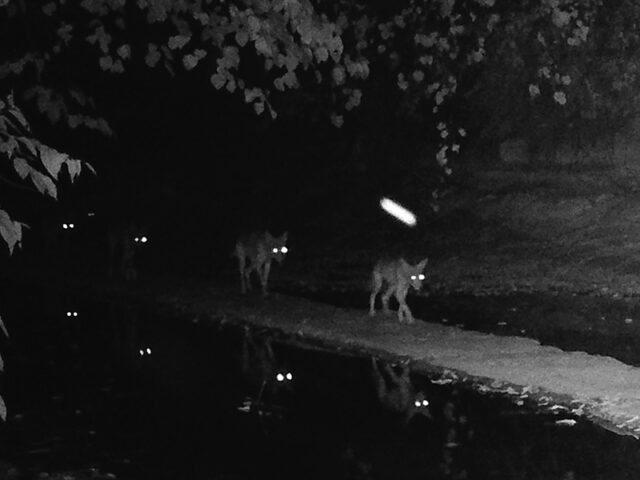


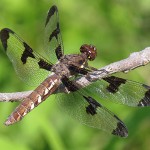
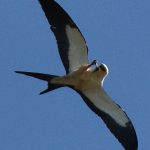



Hi Chris, You may remember that I have in-laws who live in the Brookhaven development in Farmer’s Branch. I visited there last week, and two mornings in a row around and shortly after dawn, a male coyote played on the golf course behind the house. Played is the best term I can come up with, since he followed along behind two different service vehicles as they prepared the course for the day’s play. Or maybe the maintenance personnel have been sharing their snacks with him? He also, rather half-heartedly it appeared, chased a couple of squirrels, but gave up before coming anywhere close to them, and never was faster than a lope. Just sort of feinted in their direction, really. I also wonder if garbage is something he is accustomed to foraging on, as some of the residents put their garbage out for pickup in bags rather than bins.